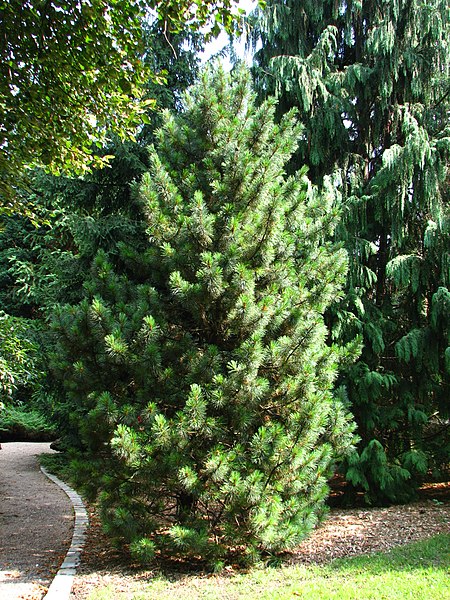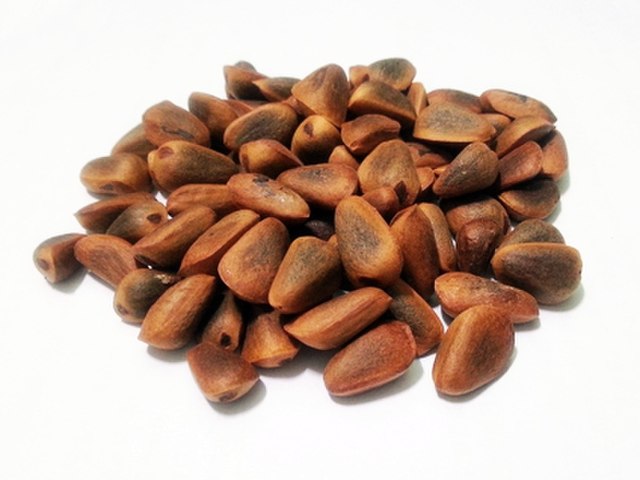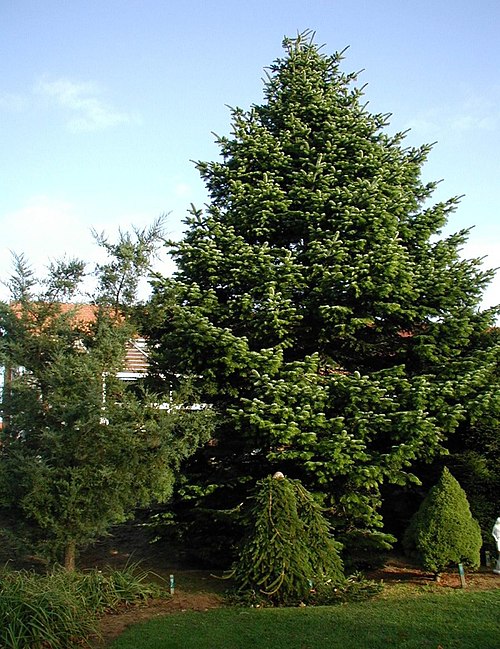Pine Trees ( Pinus Species )
Note: These seeds need to be cold statified before sowing.
We recommend using the Seedman's Cold Stratification Kits for cold stratification, these simple kits make cold stratification very easy and greatly enhances the germination of pines, cedars, junipers and other conifers.


The Korean Pine is a popular ornamental tree in cold climates and is tolerant of severe winter cold, hardy down zone 4, possibly 3. It is also used for construction, furniture, and wood pulp. The seeds have medicinal properties and are used to promote milk flow in nursing mothers and as an analgesic and antibacterial in Korea. Invest in the versatile and unique Pinus koraiensis for your garden or for its many beneficial uses. Best for zones 4-8.


Cedars ( Cedrus Species )

Although it can get more than 100' tall with an equal spread from its strong limbs, most specimens in cultivation can be expected to top out around 50-70'. In youth the tree is conical and symmetrical. The leaves, about an inch long, are stiff and 4-angled, and arranged in dense clusters on short shoots. The cones are barrel shaped, 3-5" long and held erect, a characteristic of the true cedars (genus Cedrus).
Cedar of Lebanon is very similar to (and very closely related to) Atlas cedar (C. atlantica), and some authorities consider them to be just subspecies in the same species. Michael Dirr, the famous authority on landscape trees from the University of Georgia, says Atlas cedar has a taller, less flattened crown, less densely arranged branchlets, and smaller cones (2-3" long) than cedar of Lebanon.
Location: Cedar of Lebanon is named for the famous forests that grow in Lebanon. The species also occurs in Turkey and Syria. Var. stenocoma is native to southern Turkey.
Culture: The cedars grow well in acidic sands and in thin soils over limestone; pH doesn't matter. Good drainage is essential, however. Cedar of Lebanon has a tendency to produce multiple leaders and the grower may wish to prune out the weaker shoots; do this
in autumn. These are slow growing trees.
Light: Young trees can grow in partial shade but will eventually need full sun to realize their potential.
Moisture: Cedar of Lebanon occurs naturally where there is very little summer rainfall, and is quite tolerant of drought. It can thrive where annual precipitation is no more than 15", but it also does well where 80" of annual precipitation is the norm.
Hardiness: USDA Zones 6 - 9.
Usage: The cedars make majestic specimen trees for parks, estates and larger lawns. A mature cedar of Lebanon, especially one with multiple leaders, will be as wide as it is tall, and a truly picturesque specimen.
Features: The taxonomy of the genus Cedrus is debated by the botanists. Depending on who you believe, you can recognize one, two or four species. The splitters recognize Cyprus cedar (Cedrus brevifolia), cedar of Lebanon, deodar cedar (C. deodar), and Atlas cedar.
Germination: 30-50%.

The bluish green female cones are 3-5 in (7.6-12.7 cm) long and egg shaped. After two years they shatter and release little seeds with papery wings. The bark is dark brown to nearly black, smooth on young trees and becoming fissured with age.
Deodar is native to the Himalayas, where it grows at elevations of 3,500 to 12,000 ft (1,067-3,658 m) above sea level.
Deodar is fairly fast growing for the first decade or two, growing as high as 30 ft (9.1 m) in its first 10 years. It is a long-lived and troublefree tree in most areas. Deodar needs neutral to alkaline soil.
Light: Full sun. (In whose shade is a 200 ft (61 m) tree going to grow?)
Moisture: Once established, deodar is drought tolerant.
Hardiness: USDA Zones 7 - 9.
Most cultivars of deodar will grow into large and handsome specimen trees that need plenty of room. Use these in the back of a large landscape so they can be seen in their entirety. From a distance, deodar is dense and plumose, with a fine texture, and the tip of the tree seems to wave in the breeze. Some cultivars are smaller and more shrublike. With proper pruning most deodars can be maintained as bushy shrubs.
Junipers ( Juniperus Species )

Chinese juniper can be grown in acidic or alkaline soils. These useful evergreens are very easy to grow. Can be grown in zones 3-9. The seed requires a period of cold stratification.

Considered the most widely distributed eastern conifer, native in 37 states, Eastern Red Cedar is resistant to extremes of drought, heat, and cold. Red Cedar can be injurious to apple orchards because it is an alternate host for cedar-apple rust, a fungal disease. First observed at Roanoke Island, Virginia, in 1564, it was prized by the colonists for building furniture, rail fences, and log cabins.Zones 2-9.

Trees may have male or female cones, but not both. The fruits are fleshy berrylike spherical cones, about one-third inch in diameter. They are bright blue with a whitish bloom and sweet tasting, with thin skins. Rocky Mountain juniper is closely related and quite similar to eastern redcedar, and was once believed to be the same species. But eastern redcedar has fruits that mature in a single season, whereas those of Rocky Mountain juniper take two year to ripen. Also, eastern redcedar had exfoliating bark. The two species hybridize where their ranges overlap.
Location: Rocky Mountain juniper occurs in isolated and scattered localities within a wide band from British Columbia to North Dakota, and south to Arizona and New Mexico. It grows from near sea level in the northern part of its range to more than 8000' above sea level in the south. Rocky Mountain juniper grows in alkaline soils on ridges, cliffs and rocky slopes, sometimes in pure stands, but more often in association with other mountain loving evergreens such as ponderosa pine, pinyon pine and Douglas-fir.
Culture: Rocky Mountain juniper is a slow growing tree
(6-12" per year), but one that can live more than 300 years. In
cultivation it tolerates acidic to alkaline soils, and does
best in those that are loose and well drained. It is best
adapted to culture in western and northern North America.
Light: Seedlings and saplings can tolerate rather dense shade,
but Rocky Mountain junipers, even the smaller cultivars, need
full sun to grow to their full potentials.
Moisture: Rocky Mountain juniper is tolerant of drought, but
perhaps less so than the other junipers. It should be watered
before the soil becomes completely dry. This juniper does
poorly in humid climates, but does fine in hot, dry
climates.
Hardiness: USDA Zones 4 - 7.
Usage: Use any of the cultivars of Rocky Mountain juniper for
attractive foliage effects in all seasons. This evergreen is
useful as a screen, hedge or foundation plant. They make great
anchors or focal points for the ends of hedges or mixed
borders. Rocky Mountain juniper is a tidy, formal accent shrub
alone or in small groups.
Features: Although most cultivars are probably too formal for
naturalistic gardens, Rocky Mountain juniper is ideal for neat,
well-organized landscapes. Most cultivars require little or no
pruning and are relatively free of cultural problems, insects
and diseases. They tolerate heat and drought well.
Other Conifer Types

Plus, its fragrant needles add a delightful scent to your home or garden. Use it as a stunning centerpiece for your holiday decor or as a year-round landscape specimen. Grow some and enjoy the beauty and tranquility of this wonderful tree.
It can grow 50-80 feet tall, with a spread of 10-15 feet. Best for zones 5-8.
It has branchlets that typically hang downwards, and the largest cones of any spruce, 3 to 7 inches long. The Norway spruce has a wide distribution for it being planted for its wood, and is the species used as the main Christmas tree in several countries around the world.
Norway Spruce Tree can grow to a large height in as little as three years. It will continue to grow rapidly to a mature height of 50 feet. And since it's a dense tree that easily blocks out wind and neighbors, it's ideal for use as a privacy barrier, windscreen, or even a traditional showpiece.
For zones 2-7.
This slow-growing arborvitae is used in landscapes around the world where it is associated with long life and vitality. Some large specimens growing around Buddhist temples in China are 1000 years old or older. A very beautiful Arborvitae perfect for planting below power lines because of their slow growth.
For zones 6-9.

A medium to fairly large, very long-lived conifer widely distributed in temperate forests in northeastern North America with much-branched shoots that are covered in tiny, scalelike, fragrant evergreen leaves.
The relatively slender trunk rarely reaches more than 3 feet in diameter and has flaking, reddish-brown bark. Its is one of the most popular conifers in the temperate garden in USDA Zones 2 to 8 and much used for hedges and screens.
It has many medicinal applications and the wood is very rot resistant.



This tough plant thrives in the most adverse conditions, tolerating a wide range of light exposures and soils.
A moderately slow-growing, large evergreen shrub with a strongly-columnar growth habit to 8-12' tall x 4-5' wide. Can be pruned into a small tree. This popular and useful variety features dense-growing medium to deep-green foliage that takes very well to shearing, making it an ideal selection for use as a hedge, screen, background, column or topiary.
Perfect for framing an entryway, for large patio containers, or anywhere a tall, narrow-growing specimen is required. Prefers a neutral to slightly-acidic loamy soil, as clay soils will tend to produce a weaker, less aesthetically-pleasing specimen. Thrives in a partial to full sun exposure.
Zones 7b-11.




